Maximizing ROI: Sales Funnel Optimization for Mid-Sized Countertop Businesses
The #1 tip for maximizing ROI in sales funnel optimization for mid-sized countertop businesses is to focus on personalized follow-ups and nurturing leads through tailored content, guiding prospects from initial interest to final purchase with targeted, relevant communication. Mid-sized counter businesses in a competitive market must maximize return on investment by optimizing every aspect of operations. Optimizing the sales funnel is one of the best ways to do this. A well-structured funnel can help businesses guide their prospects through the entire buying process from the initial awareness phase to the final sale, while ensuring that there are minimal drop-offs. This article examines the key strategies that businesses can use to refine their sales funnels, ultimately leading them to improved ROI and sustainable business growth.
Click on each corresponding link to jump ahead:
- Sales Funnel
- Tracking and Measuring Sales Funnel Performance
- Adapting to Market Trends
- Sales Funnel Examples
- Best Sales Funnel Software
- What Is A Sales Funnel Strategy
- What Is Sales Funnel Optimization
- Best Free Sales Funnel Templates
- Best Sales Funnel Optimization Tools
If you are looking to work with professionals in the SEO field for countertop companies, contact Profitworks.
1) Sales Funnel
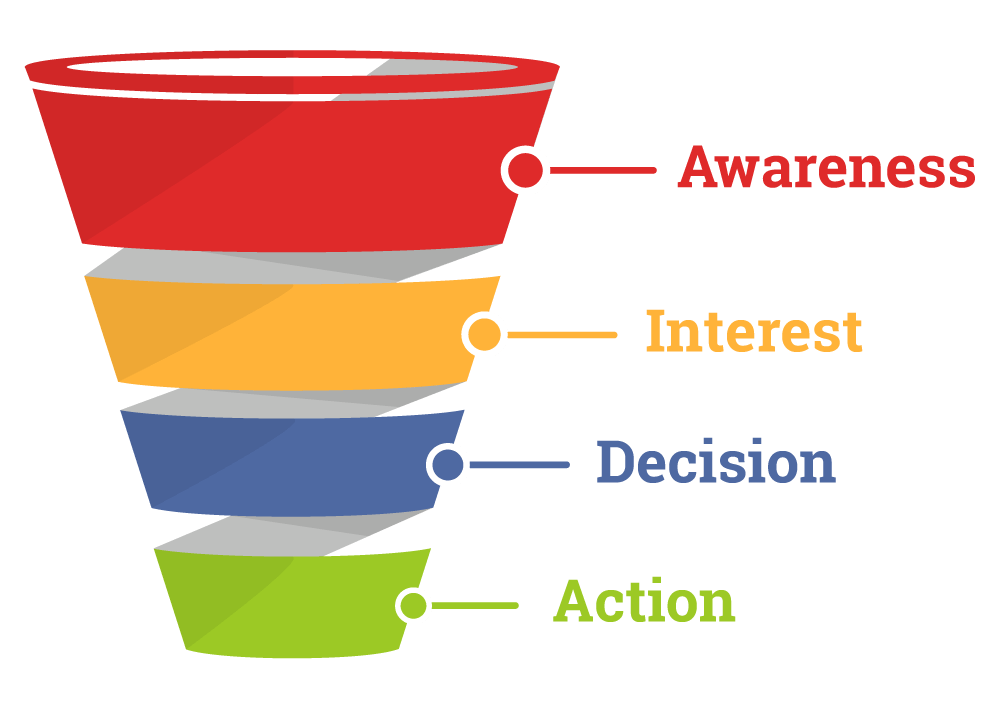
Source: Hello Digital
The sales funnel is a multi-stage process designed to attract, engage, and convert prospects into paying customers. It typically includes four stages: awareness, interest, decision, and action. Each stage plays a critical role in driving the customer closer to a purchase, making it crucial for mid-sized countertop businesses to ensure that every part of the funnel is performing optimally. In many cases, business owners might seek to refine their marketing approach or even enlist professional services, asking, “Can someone write my papers on sales strategies?” This underscores the importance of research and strategy in business optimization, particularly when tackling the complexity of sales funnel management.
Stage 1: Awareness
The awareness stage is the first time potential customers learn about your counter business. The goal of this stage is to catch as many leads as possible. SEO and content marketing can all play an important role in increasing brand awareness.
For mid-sized countertop businesses, investing in local SEO is particularly effective. By targeting keywords that relate to the industry and your geographic area, you increase the chances of appearing in local search results when potential customers are looking for countertop services. Additionally, content marketing in the form of blogs, case studies, and informative videos can help showcase your expertise, making your brand more attractive to potential clients.
Stage 2: Interest
Once a potential customer becomes aware of your business, the next step is to spark their interest. This involves providing valuable information that speaks directly to their needs and positions your countertop business as the best solution. Email marketing campaigns, product demonstrations, and tailored content can be powerful tools to keep your leads engaged during this stage.
In the countertop business, showing potential customers the quality and variety of materials you offer can make all the difference. Offering virtual consultations or even live chat options on your website helps create an immediate connection and builds trust with the customer. The more personalized the experience, the higher the likelihood that interested prospects will move to the decision-making phase of the funnel.
Stage 3: Decision
The decision stage is where potential customers evaluate their options and make a final choice. To nudge them toward choosing your countertop business, offering incentives like discounts, financing options, or limited-time offers can make a significant impact. Additionally, customer testimonials, case studies, and high-quality images of your previous work can provide the social proof needed to build confidence in your products and services.
Another crucial aspect of this stage is having a clear and user-friendly checkout process. Any friction during the purchase process, such as lengthy forms or a lack of payment options, can cause prospects to abandon their cart. Ensuring that the decision-to-action pathway is seamless will lead to higher conversions and, subsequently, an optimized sales funnel.
Stage 4: Action
The final stage of the sales funnel is the action stage, where the customer makes the purchase. However, optimization doesn’t end here. Ensuring a positive post-purchase experience is key to securing repeat business and generating referrals. Follow-up emails, satisfaction surveys, and loyalty programs can enhance customer retention and encourage customers to become brand advocates for your countertop business.
Mid-sized businesses often overlook the importance of after-sales service, but it can play a significant role in long-term profitability. By maintaining a relationship with the customer even after the sale, you create opportunities for future projects and referrals. This consistent engagement is what will help you maximize ROI over time.
2) Tracking and Measuring Sales Funnel Performance
It's crucial to measure and track the effectiveness of every step in your sales funnel if you want to maximize ROI. Metrics like conversion rates, average deals, and customer acquisition cost can give valuable insight into which parts of your funnel need improvement.
For countertop businesses, analyzing how potential customers move through the funnel allows you to identify any gaps or bottlenecks. If you notice a significant drop-off between the interest and decision stages, for example, it may indicate that your messaging isn’t compelling enough, or that your pricing structure needs adjustment. Continually optimizing the funnel based on data will lead to a more efficient sales process and, ultimately, better returns on investment.
3) Adapting to Market Trends
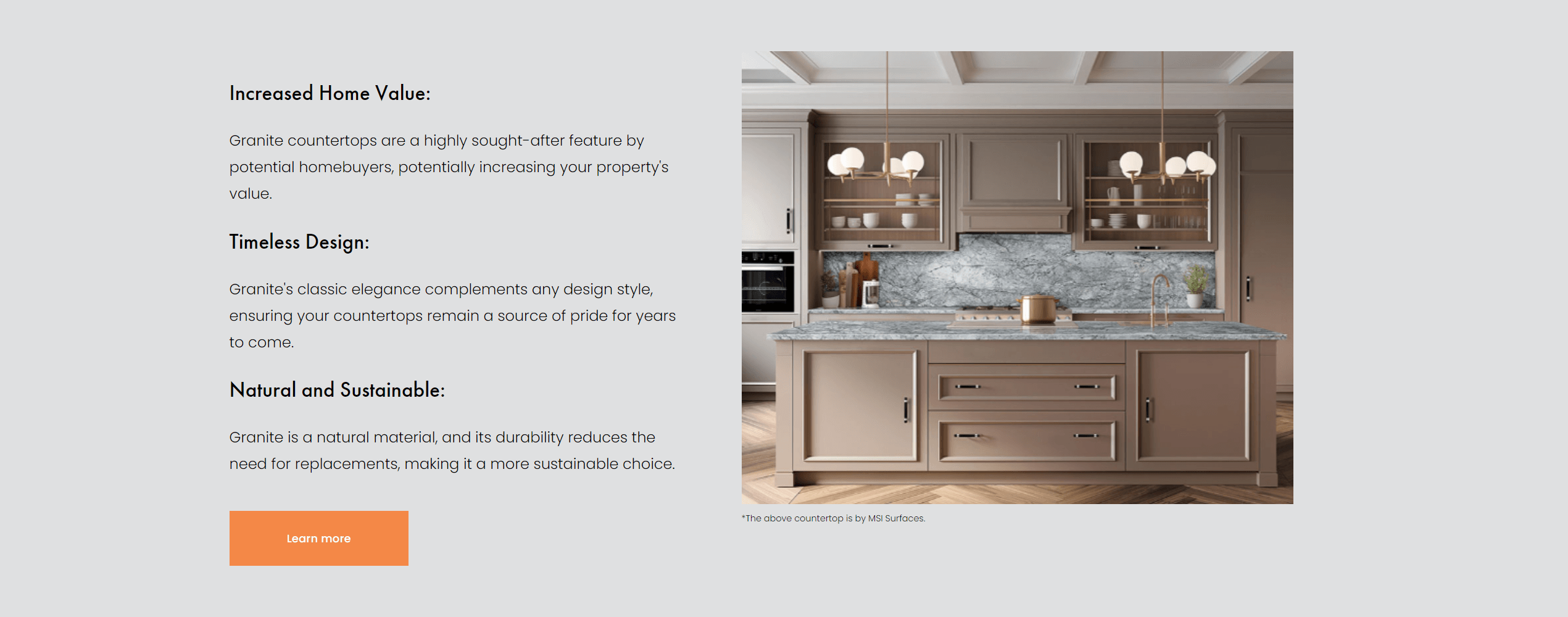
Source: Natural Stone City
The countertop industry, like any other, is subject to market trends and shifts in consumer behaviour. As such, your sales funnel should be flexible enough to adapt to these changes. Keeping an eye on emerging trends—whether it’s new materials, eco-friendly options, or changes in customer preferences—can help you stay ahead of the competition.
Mid-sized countertop businesses that are proactive about adapting their sales funnel to reflect these trends will see a greater impact on their ROI. For example, if customers begin showing a preference for sustainable materials, incorporating this into your marketing efforts can attract a new segment of environmentally-conscious buyers. Being responsive to the market ensures that your sales funnel remains relevant and effective over time.
4) Sales Funnel Examples
Optimizing the sales funnel for a mid-sized countertop business is crucial to maximizing ROI. A well-structured funnel guides prospects through the buying journey, from initial awareness to final purchase, and here are a few practical examples tailored to this industry:
1. Awareness Stage: Targeted Blog Content and SEO
At the top of the funnel, potential customers are looking for information about countertop materials, styles, and installation processes. Mid-sized countertop businesses can attract these leads through SEO-optimized blog posts, such as "Granite vs. Quartz: Which is Right for Your Kitchen?" or "How to Choose the Perfect Countertop for Your Home Renovation." These articles are designed to educate and attract traffic while subtly positioning your business as an expert in the field. Including a call-to-action (CTA) for a free guide or consultation encourages users to enter the funnel.
2. Consideration Stage: Product Comparisons and Case Studies
In the consideration stage, leads evaluate different countertop options and companies. Offering detailed product comparison pages, case studies of past projects, or video testimonials from satisfied customers helps nurture these prospects. For example, a detailed comparison between granite, marble, and quartz countertops, along with real-life case studies showcasing kitchen makeovers, gives potential buyers the insights they need to trust your business. A CTA for a free design consultation or an in-store visit can move them further down the funnel.
3. Decision Stage: Personalized Quotes and Incentives
At the decision stage, leads are ready to choose a provider. Offering a personalized quote based on their project specifications or a limited-time offer (such as a discount on installation) can nudge them towards making a purchase. For instance, after engaging with your product comparison tools, users can request a custom quote directly from your site. Following up with an email that includes their tailored estimate and a discount on materials or installation further encourages conversion.
4. Post-Purchase Stage: Follow-Up and Referral Programs
The funnel doesn’t end at the sale. After purchase, you can further boost ROI by following up with installation guides, maintenance tips, and satisfaction surveys. Additionally, offering referral incentives for customers who recommend your countertop business to friends or family can help generate new leads and retain customers. For instance, a referral program offering a discount on future services or a gift card can turn satisfied customers into brand advocates.
5) Best Sales Funnel Software
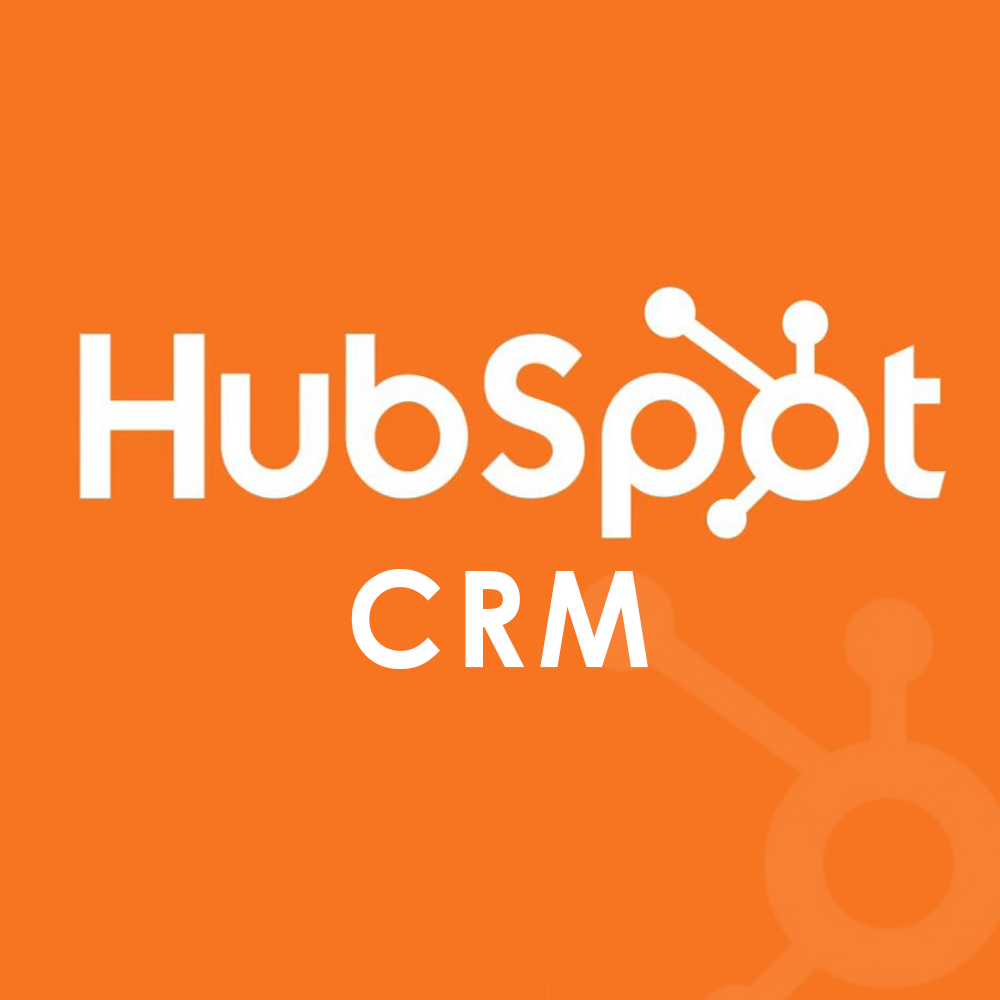
Source: Hubspot
Choosing the right sales funnel software is critical for optimizing customer journeys and maximizing ROI in mid-sized countertop businesses. The right tools help streamline lead management, track customer interactions, and automate key stages in the sales process. Here are some of the best sales funnel software options that can help mid-sized countertop companies boost efficiency and drive conversions:
1. HubSpot CRM
HubSpot CRM is an all-in-one platform offering powerful tools to manage your sales funnel from start to finish. With features like lead tracking, email automation, and detailed analytics, it enables countertop businesses to engage leads with personalized emails and nurture them through the funnel with tailored content. Its free version offers robust features, and premium versions include advanced capabilities like sales automation and reporting.
2. ClickFunnels
ClickFunnels is a popular platform designed for building and optimizing sales funnels. For mid-sized countertop businesses, ClickFunnels makes it easy to create custom landing pages, lead capture forms, and follow-up email campaigns. The drag-and-drop builder simplifies creating visually appealing, high-converting sales pages that guide potential buyers through every stage of the funnel—from awareness to purchase. Its automation features, including abandoned cart follow-ups, help reduce drop-offs.
3. ActiveCampaign
ActiveCampaign excels in email marketing automation, making it ideal for nurturing leads throughout the sales funnel. For countertop businesses, it can be used to create highly personalized email sequences that deliver relevant content to leads based on their behavior—whether they’ve downloaded a countertop guide, requested a quote, or signed up for a consultation. The platform also includes CRM tools, sales automation, and advanced segmentation to help businesses better target leads at different funnel stages.
4. Keap (formerly Infusionsoft)
Keap is a comprehensive CRM and sales funnel tool that’s perfect for mid-sized businesses looking to automate lead management and follow-ups. With Keap, countertop businesses can manage leads through customized pipelines, automate emails, schedule follow-ups, and even track customer interactions from one centralized platform. Its user-friendly interface and customizable workflows make it easy to build a seamless sales process that maximizes conversions.
5. Pipedrive
Pipedrive is a sales-focused CRM designed to help businesses manage leads and sales pipelines efficiently. It allows countertop businesses to track every step of the buyer’s journey, from initial contact to closing the sale. Its visual pipeline makes it easy to monitor where prospects are in the funnel, set follow-up reminders, and keep deals moving forward. With integrations for email marketing and automation tools, Pipedrive ensures that no lead falls through the cracks.
6. Zoho CRM
Zoho CRM is a flexible, cost-effective solution that can be tailored to suit mid-sized countertop businesses. It offers features like lead scoring, workflow automation, and real-time reporting to help manage and optimize sales funnels. Zoho CRM also integrates with a variety of other tools, making it a versatile choice for businesses looking to streamline their sales processes and improve ROI.
Each of these sales funnel software platforms offers unique features that can help mid-sized countertop businesses effectively manage and optimize their sales funnels, improve lead engagement, and ultimately drive more conversions. By choosing the right tool, businesses can automate repetitive tasks, track customer journeys, and focus on what matters most—turning leads into loyal customers.
6) What Is A Sales Funnel Strategy
A sales funnel strategy is a systematic approach that outlines the steps a business takes to guide potential customers through the purchasing process, from initial awareness to final conversion and beyond. The concept of a sales funnel visualizes the journey of prospects, illustrating how they move through different stages of engagement and decision-making. Here’s a breakdown of what a sales funnel strategy involves:
1. Understanding the Stages of the Funnel
A typical sales funnel consists of several stages:
-
Awareness: At the top of the funnel, potential customers become aware of your brand and products. This stage involves generating traffic through marketing efforts, such as content marketing, social media, and paid ads.
-
Interest: Once prospects are aware of your brand, they show interest in your offerings. This is where you provide valuable content, like blog posts or videos, that addresses their needs and pain points.
-
Consideration: At this stage, leads evaluate your product against competitors. Providing detailed information, such as product comparisons, case studies, and testimonials, helps nurture these prospects.
-
Intent: Prospects demonstrate intent to purchase, often by engaging with your website, requesting quotes, or adding items to their cart. Effective follow-ups and personalized communication are key at this stage.
-
Conversion: This is the stage where prospects become customers by making a purchase. Strategies to optimize this stage include offering incentives, like discounts or free consultations, to encourage final decisions.
-
Post-Purchase: After the sale, businesses should focus on customer retention and advocacy. Follow-up communications, asking for feedback, and offering loyalty programs help build long-term relationships.
2. Identifying Target Audiences
An effective sales funnel strategy requires a deep understanding of your target audience. This includes identifying their demographics, preferences, pain points, and behaviors. By creating detailed buyer personas, businesses can tailor their marketing messages and tactics to resonate with specific audience segments at each stage of the funnel.
3. Crafting Tailored Content and Offers
To move prospects through the sales funnel, businesses must develop relevant and engaging content for each stage. This can include blog articles, eBooks, webinars, case studies, and promotional materials. The content should address the specific needs and questions of potential customers, guiding them toward making informed decisions.
4. Utilizing Marketing Automation Tools
Sales funnel strategies often involve using marketing automation tools to streamline processes, track customer interactions, and nurture leads. These tools can automate email campaigns, segment audiences, and provide insights into user behavior, allowing businesses to optimize their funnel effectively.
5. Analyzing and Optimizing Performance
A successful sales funnel strategy requires ongoing analysis of key performance metrics, such as conversion rates, click-through rates, and customer feedback. By regularly reviewing this data, businesses can identify bottlenecks, assess the effectiveness of their content and marketing efforts, and make informed adjustments to enhance the overall performance of the sales funnel.
7) What Is Sales Funnel Optimization
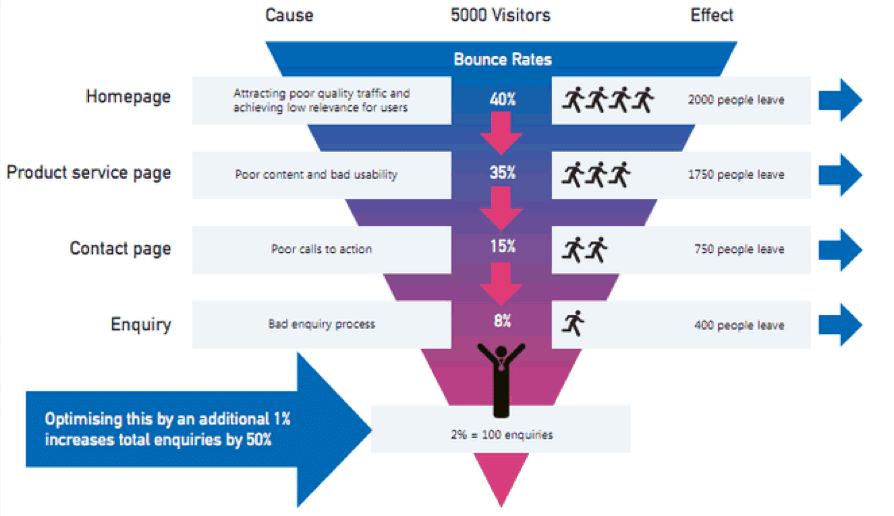
Source: Invesp
Sales funnel optimization is the process of refining and enhancing each stage of the sales funnel to improve conversion rates and maximize revenue. The goal is to make the journey from prospect awareness to final purchase as seamless and efficient as possible, ensuring that potential customers have a positive experience and are more likely to convert into paying clients. Here’s a closer look at what sales funnel optimization involves:
1. Analyzing the Funnel Stages
Sales funnels typically consist of several stages—awareness, interest, consideration, intent, conversion, and post-purchase. Optimization begins with analyzing each stage to identify areas for improvement. This may involve tracking metrics such as drop-off rates, conversion rates, and user engagement levels at each point in the funnel.
2. Identifying Bottlenecks and Barriers
During the analysis phase, businesses should pinpoint bottlenecks or barriers that may be hindering the conversion process. For example, if a significant number of prospects are dropping off at the consideration stage, it could indicate that they’re not finding enough information to make an informed decision. Identifying these pain points allows businesses to take targeted actions to improve the funnel.
3. Enhancing User Experience
Improving user experience (UX) is a critical component of sales funnel optimization. This can involve simplifying navigation, reducing loading times, and ensuring that the website is mobile-friendly. By creating a user-friendly interface, businesses can facilitate a smoother journey for prospects and encourage them to move further down the funnel.
4. Creating Targeted Content
Tailored content plays a vital role in engaging potential customers at each stage of the funnel. Sales funnel optimization involves creating specific content types—such as informative blog posts, engaging videos, case studies, and compelling CTAs—that align with the needs and interests of prospects. Providing relevant and valuable information can help nurture leads and guide them toward making a purchase.
5. Implementing Marketing Automation
Utilizing marketing automation tools can streamline and enhance the sales funnel process. Automation allows businesses to nurture leads through personalized email campaigns, segment audiences based on behaviors, and track interactions in real-time. By automating repetitive tasks, sales teams can focus more on high-value activities that drive conversions.
6. Testing and Iterating
Sales funnel optimization is an ongoing process that involves continuous testing and iteration. A/B testing different elements—such as headlines, landing page designs, and CTA placements—can provide valuable insights into what resonates best with your audience. Based on the results, businesses can make data-driven adjustments to further enhance funnel performance.
7. Measuring and Analyzing Results
To gauge the success of optimization efforts, businesses must consistently measure and analyze key performance indicators (KPIs), such as conversion rates, lead quality, and customer lifetime value. By tracking these metrics, businesses can evaluate the effectiveness of their sales funnel strategies and identify new opportunities for improvement.
8) Best Free Sales Funnel Templates
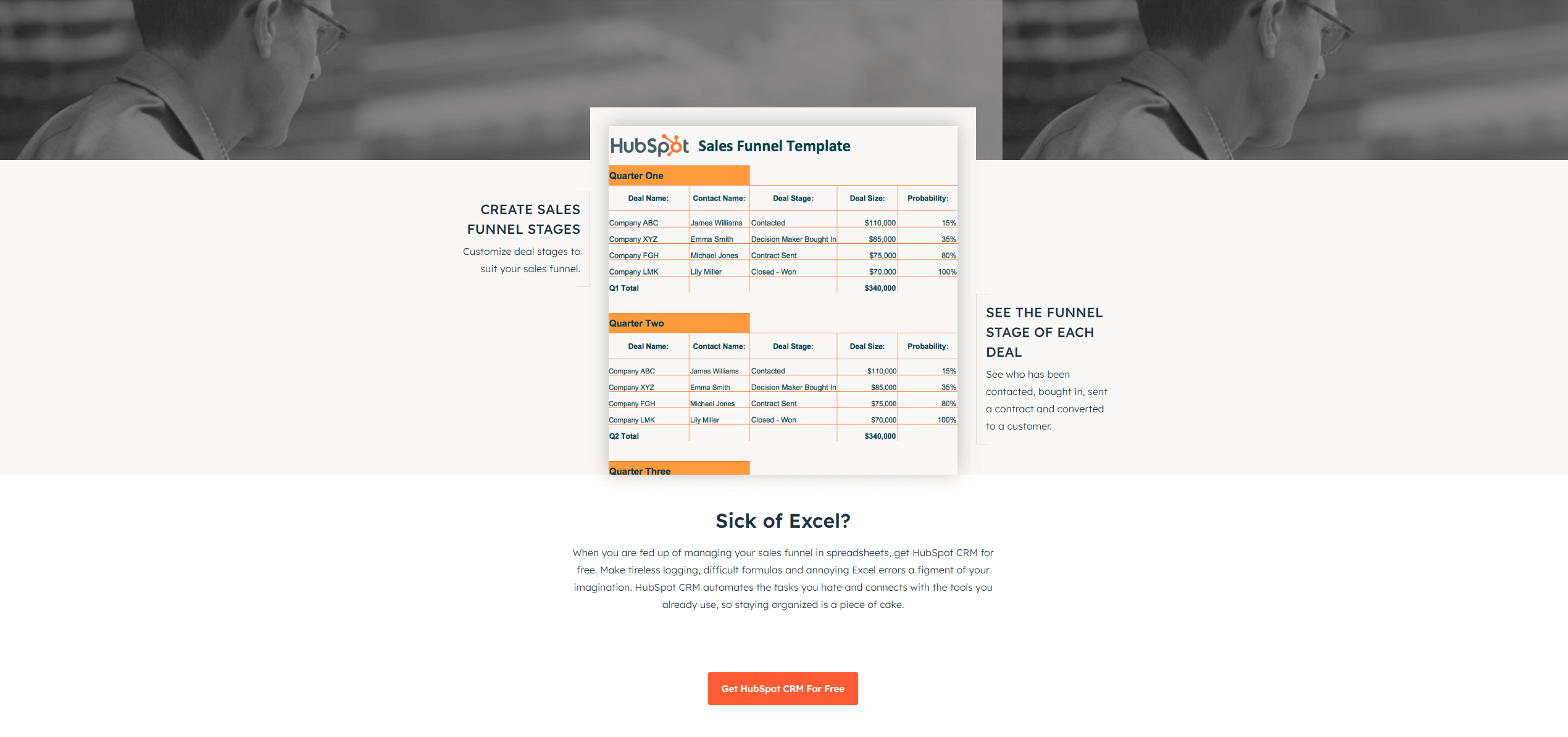
Source: HubSpot
Sales funnel templates can provide a valuable starting point for businesses looking to streamline their customer acquisition process. Here are some of the best free sales funnel templates available that can help you effectively manage your leads and optimize your sales strategy:
1. HubSpot Sales Funnel Template
HubSpot offers a comprehensive sales funnel template as part of its free resources. This template allows businesses to visualize each stage of their funnel, from lead generation to conversion. It includes sections for tracking leads, setting goals, and monitoring conversion rates, making it easy to manage your sales process effectively.
2. Google Sheets Sales Funnel Template
Google Sheets provides a customizable sales funnel template that can be adapted to your specific business needs. You can track leads at different stages, set deadlines, and visualize your pipeline using charts and graphs. Its collaborative features also allow team members to contribute and access the template from anywhere.
3. Canva Sales Funnel Infographic Template
Canva offers free infographic templates that can be used to create visually appealing sales funnels. These templates can be customized to represent your unique sales process, making it easy to present your funnel to your team or stakeholders. The drag-and-drop interface makes it simple to add elements and modify the design to suit your branding.
4. Venngage Sales Funnel Diagram Template
Venngage provides a range of free sales funnel diagram templates that can be easily customized. These templates are designed to create clear visual representations of your sales process, helping you identify stages and strategies at a glance. Venngage also offers various design options to match your branding and style.
9) Best Sales Funnel Optimization Tools
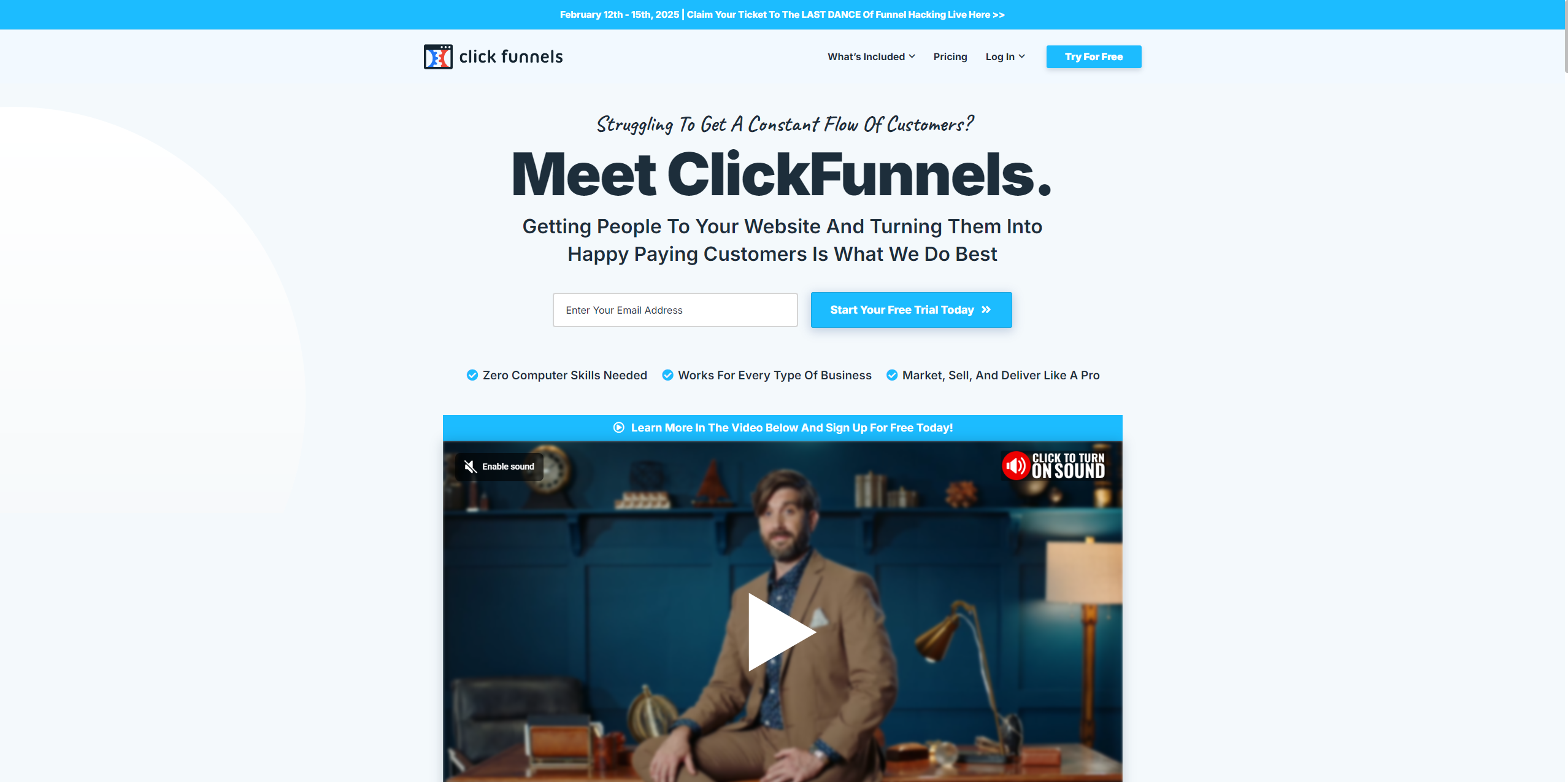
Source: Click Funnels
Optimizing your sales funnel is crucial for maximizing conversions and increasing revenue. There are several tools available that can help streamline the process, enhance user experience, and provide valuable insights. Here’s a list of some of the best sales funnel optimization tools to consider:
1. ClickFunnels
ClickFunnels is a popular all-in-one sales funnel builder that allows you to create high-converting landing pages, sales pages, and complete funnels with ease. With its drag-and-drop interface, you can design funnels tailored to your business needs without any coding knowledge. ClickFunnels also includes features for email marketing, payment processing, and analytics to track performance.
2. HubSpot CRM
HubSpot CRM is a powerful customer relationship management tool that offers a comprehensive suite of sales and marketing features. It includes lead tracking, email automation, and sales pipeline management, making it an excellent choice for optimizing your sales funnel. HubSpot's reporting tools provide insights into funnel performance, helping you identify areas for improvement.
3. Unbounce
Unbounce specializes in creating landing pages designed to convert visitors into leads. This tool offers A/B testing, dynamic text replacement, and customizable templates to optimize landing page performance. Unbounce's integration with various marketing tools ensures that your funnels are seamlessly connected to your overall marketing strategy.
4. Leadpages
Leadpages is another powerful landing page builder that helps businesses create high-converting pages quickly. It features a user-friendly drag-and-drop editor and a variety of templates optimized for conversions. Leadpages also includes built-in analytics to track page performance, allowing you to make data-driven decisions to optimize your funnel.
5. ActiveCampaign
ActiveCampaign is an email marketing and marketing automation platform that allows businesses to nurture leads throughout the sales funnel. With advanced segmentation and personalization features, you can send targeted emails based on user behavior. ActiveCampaign also provides automation workflows that help guide leads through the funnel, increasing the likelihood of conversion.
